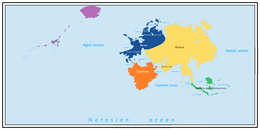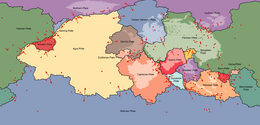Aurorum (region): Difference between revisions
No edit summary |
|||
| Line 58: | Line 58: | ||
The inner Solar System comprise the four {{wp|terrestrial planet|terrestrial planets}}, made up of {{wp|refractory (planetary science)|refractory}} materials such as {{wp|silicate|silicates}} and {{wp|metal|metals}} which from the planets' respective {{wp|crust (geology)|crusts}} and {{wp|Earth's mantle|mantles}}, as well as one {{wp|gas giant}} consisting mainly of gasses such as {{wp|hydrogen}} and {{wp|helium}}. The boundary of this region is scientifically arbitrary as there is no system feature that denotes an exact border, though all planets of the inner Solar System have substantial {{wp|atmosphere|atmospheres}}, no {{wp|ring system|ring systems}}, few to no {{wp|moon|moons}} and are all located within the system's {{wp|frost line (astrophysics)|frost line}}. | The inner Solar System comprise the four {{wp|terrestrial planet|terrestrial planets}}, made up of {{wp|refractory (planetary science)|refractory}} materials such as {{wp|silicate|silicates}} and {{wp|metal|metals}} which from the planets' respective {{wp|crust (geology)|crusts}} and {{wp|Earth's mantle|mantles}}, as well as one {{wp|gas giant}} consisting mainly of gasses such as {{wp|hydrogen}} and {{wp|helium}}. The boundary of this region is scientifically arbitrary as there is no system feature that denotes an exact border, though all planets of the inner Solar System have substantial {{wp|atmosphere|atmospheres}}, no {{wp|ring system|ring systems}}, few to no {{wp|moon|moons}} and are all located within the system's {{wp|frost line (astrophysics)|frost line}}. | ||
====X==== | |||
is the closest planet to the Sun and the third-largest planet of the system (approximately 17 {{wp|Earth mass|''M''<sub>🜨</sub>}}) due to it being a {{wp|gas giant}}. The planet has no natural satellites, but a noticably short {{wp|orbital period}} of 24 days which warranted the current classification of X as a {{wp|Hot Jupiter|hot X}}, as well as a {{wp|retrograde motion|retrograde orbit}}. Due to its proximity to the Sun, it remains {{wp|tidal locking|tidally locked}} with the planetary day side experiencing high stellar irradiation and a temperature difference of some 500 K in comparison to its night side. This environment allows for intense {{wp|wind}} currents, radical {{wp|Atmosphere of Earth#Stratification|atmospheric stratification}} and super-rotating equatorial {{wp|jet stream|jet streams}} and {{wp|storm|storm vortices}}. X's origin and history have not yet been explained, though the {{wp|planetary migration}} hypothesis is generally ruled to be the most likely one. It is probable X will eventually be stripped bare of its atmosphere due to {{wp|hydrodynamic escape}} and become a {{wp|chthonian planet}} some 2.3 billion years in the future. | |||
====X==== | |||
TBD | |||
====Aurorum==== | |||
Aurorum, or Earth, is the TBD | |||
====Luna==== | |||
Luna TBD | |||
====X==== | |||
X TBD | |||
===Outer Solar System=== | ===Outer Solar System=== | ||
====X==== | |||
X TBD | |||
====Asteroid belt==== | |||
The asteroid belt TBD | |||
====Atiner==== | |||
Atiner TBD | |||
====X==== | |||
X TBD | |||
==Human history== | ==Human history== | ||
===Ancient history and antiquity=== | ===Ancient history and antiquity=== | ||
Revision as of 12:48, 19 October 2021
This article is incomplete because it is pending further input from participants, or it is a work-in-progress by one author. Please comment on this article's talk page to share your input, comments and questions. Note: To contribute to this article, you may need to seek help from the author(s) of this page. |
| Designations | |
|---|---|
| Earth (the) World | |
| Orbital characteristics | |
| Eccentricity | 0.026 |
| 365.593 days | |
Average orbital speed | 27.3 km/s |
| Satellite of | Luna |
| Physical characteristics | |
Mean radius | 4,891.1 km |
| 296,012,380 km2 | |
Mean density | 7.280 g/cm3 |
| 9.694 m/s2 | |
| 10.706 km/s | |
| 0.9972 d (23h 49m 6.3s) | |
| 24.04° | |
| Atmosphere | |
Surface pressure | 100.2834 kPa |
Aurorum, commonly known as Earth or the World, is a terrestrial planet orbiting the Sun. It is the fifth-largest and fifth-most-massive object in the Solar System, as well as the only currently known celestial object in the Solar System and the known universe to harbor and sustain life. Additionally, it is the largest and densest of the Solar System's rocky planets. Aurorum constitutes a binary planetary system together with its only natural satellite, the Moon or Luna, that makes up 40% of the binary system's total mass and interacts with the respective other gravitationally.
Aurorum is unique in that its surface consists partly of liquid water, both as salt-water and freshwater, making up the hydrosphere, and an active planetary geology with mechanically rigid tectonic plates constituting the lithosphere above a planetary interior of a solid inner core, fluid outer core and convecting mantle layer, active geothermal activity which produce volcanic activity, earthquakes and a stable geomagnetic field. This allows the planet to have developed a rich atmosphere consisting mainly of nitrogen, oxygen and other gasses, which in turn results in the constitution of the water cycle, greenhouse effect and weather existing as a dynamic system on Aurorum.
Various factors such as the aforementioned and particularly Aurorum's distance from the Sun allowed for the planet to proliferate anaerobic and later aerobic life some 4.1 billion years ago. Since, life has evolved and thrived over long periods of Aurorum's history, spawning a plethora of biodiversity and occassionally punctuated by mass extinction events. Today, the modern human (homo sapiens) inhabits Aurorum and has increasingly altered its climate and atmosphere, biosphere and surface in what is dubbed the "anthropocene".
Etymology
The generally accepted and scientific Fallish name of the planet Aurorum was derived from the Cambran loanword aurorum, the genitive plural of aurum, the Cambran word for gold and the origin of its chemical symbol "Au". The related Aurora refers to dawn and inherently the goddess of dawn in Cambran mythology, announcing the renewal and arrival of Sol (the Sun) each morning, before voyaging across the sky and setting at evening; she is often seen as a personified deity of Aurorum itself.
The planet is commonly referred to as Earth in non-scientific circles, traced back to the Old Fallish noun of eorðe which translates the concept of "the ground", soil and ultimately the "world" as a cohesive body. Other domestically used names for Aurorum include the Hesurian Erde and Dalish Jorden, with every Hesurianic language having approximate cognates, the Cambran Terra found as cognates in almost every Cambrance language, and the Dulebian Земля (Zemlya) in various Pomoric vocabularies, all reflecting their origin to a word for "soil/ground".
Physical characteristics
Oceans and continents
Most of Aurorum's surface is subdivided into oceans, which constitute the majority of its hydrosphere, and continents, which are the planet's largest landmasses. By convention, the four oceans consist of the Iremic, Agric, Notosian, and Caphtoric, generally seen as parts of a continuous world ocean, while the five regions considered as continents consist of Pamira, Berea, Caphtora, Melasia and Mavronesia, and Alvinia. The boundaries of the continents are also influenced, albeit often times arbitrarily, by the groupings of sovereign states into regions defined by joint historic and or cultural heritage. By geologic perception, Aurorum's continents roughly correspond to the surface presence of continental crust, though continental crustal fragments such as various islands and continental crust submerged by the ocean are not commonly referred to as distinct continents.
Due to Aurorum's vivid tectonic and other geological activity, its surface and relief is made up of ocean trenches and graben, plateaus, mountain ranges and other forms of topography. The deepest underwater location of Aurorum's seabed is the Tartarus Deep of the Alvinian Trench in the eastern Iremic Ocean, with a depth of 11,038 m (36,214 ft). Aurorum's highest mountain above sea level is Mount X, located in the X mountain sub-range of the X and its elevation established to be 8,262 m (27,103 ft).
Tectonic plates
Due to their ambiguous boundaries and mutual exertion of influence via tectonic movement and other actions, tectonic plates are usually determined similarly to Aurorum's continents through scientific consensus. It is agreed that there are six to seven major tectonic plates (so-called primary plates) currently in existence, comprising the lithosphere: the Agric, Caphtoran, Dentro-Telmerian, Pamiran (often subdivided into the Ashiric and Iremic Plates), Northern and Notosian Plates. These plates make up the majority of the planet's continental and oceanic crust, though there are approximately two dozen smaller and minor plates (so-called secondary plates) which inhabit spaces between the larger plates; the largest of which include the Alvinian, Appiric, Erytherian, Hahrnig, Siantric, Manatan, Mavronesian, Melasian, and Savo Plates.
Orbit and rotation
Satellites
Luna-Aurorum system
Solar System
Inner Solar System
The inner Solar System comprise the four terrestrial planets, made up of refractory materials such as silicates and metals which from the planets' respective crusts and mantles, as well as one gas giant consisting mainly of gasses such as hydrogen and helium. The boundary of this region is scientifically arbitrary as there is no system feature that denotes an exact border, though all planets of the inner Solar System have substantial atmospheres, no ring systems, few to no moons and are all located within the system's frost line.
X
is the closest planet to the Sun and the third-largest planet of the system (approximately 17 M🜨) due to it being a gas giant. The planet has no natural satellites, but a noticably short orbital period of 24 days which warranted the current classification of X as a hot X, as well as a retrograde orbit. Due to its proximity to the Sun, it remains tidally locked with the planetary day side experiencing high stellar irradiation and a temperature difference of some 500 K in comparison to its night side. This environment allows for intense wind currents, radical atmospheric stratification and super-rotating equatorial jet streams and storm vortices. X's origin and history have not yet been explained, though the planetary migration hypothesis is generally ruled to be the most likely one. It is probable X will eventually be stripped bare of its atmosphere due to hydrodynamic escape and become a chthonian planet some 2.3 billion years in the future.
X
TBD
Aurorum
Aurorum, or Earth, is the TBD
Luna
Luna TBD
X
X TBD
Outer Solar System
X
X TBD
Asteroid belt
The asteroid belt TBD
Atiner
Atiner TBD
X
X TBD
Human history
Ancient history and antiquity
Post-classical history
Early modern era
Modern era
Human geography
| Name | Capital | Population | Continent | Head of state | Head of government | Government type |
|---|---|---|---|---|---|---|
| 38,275,816 (2020) | Pamira | Shimon ben-Yaakov | Levana bat-Meshulam | One-party state | ||
| 4,271,073 (2016) | Alvinia | Actuq Tsultloya | Camilla Saquha | Presidential republic | ||
| 44,794,500 (2020) | Berea | Edwin IV | Clifford Goodwin (protecting) Ale Dykstra |
Absolute monarchy | ||
| 29,894,117 (2017) | Berea | Alexey Volodin | Vladimir Klishas | Presidential republic | ||
| 48,972,336 (2018) | Berea | Dorothea I | Thomas Falkner | Federal parliamentary constitutional monarchy | ||
| 24,621,037 (2020) | Berea | Karl III | Magnus Kjærsgaard | Unitary parliamentary constitutional monarchy | ||
| 18,042,854 (2018) | Berea | Stanisława I | Karol Kowalczyk | Unitary parliamentary constitutional monarchy |


